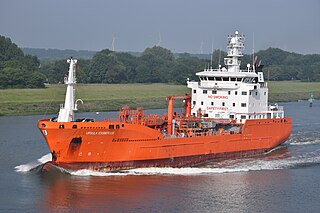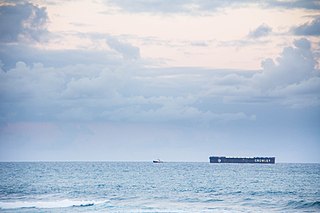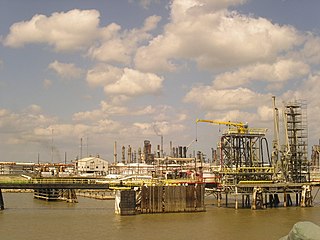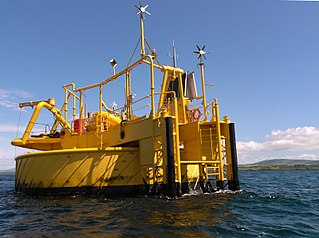
The Port of Alaska (POA) is a deep-water port in Anchorage, Alaska, with three bulk carrier berths, two petroleum berths, and one barge berth. The name was changed from "Port of Anchorage" to the "Port of Alaska" in 2017. It is an enterprise department of the Municipality of Anchorage. It is distinguished from other types of municipal departments largely because it generates enough revenue to support its operations without being a burden to Anchorage property tax payers, and it also pays a fee-in-lieu of taxes to help run city government.

A chemical tanker is a type of tanker ship designed to transport chemicals in bulk. As defined in MARPOL Annex II, chemical tanker means a ship constructed or adapted for carrying in bulk any liquid product listed in chapter 17 of the International Bulk Chemical Code. As well as industrial chemicals and clean petroleum products, such ships also often carry other types of sensitive cargo which require a high standard of tank cleaning, such as palm oil, vegetable oils, tallow, caustic soda, and methanol.

A tanker is a ship designed to transport or store liquids or gases in bulk. Major types of tankship include the oil tanker, the chemical tanker, cargo ships, and a gas carrier. Tankers also carry commodities such as vegetable oils, molasses and wine. In the United States Navy and Military Sealift Command, a tanker used to refuel other ships is called an oiler but many other navies use the terms tanker and replenishment tanker. Tankers were first developed in the late 19th century as iron and steel hulls and pumping systems were developed. As of 2005, there were just over 4,000 tankers and supertankers 10,000 LT DWT or greater operating worldwide.

Hammac was a steam tank ship built in 1920–1921 by Bethlehem Shipbuilding Corporation of Alameda for the United States Shipping Board as part of the wartime shipbuilding program of the Emergency Fleet Corporation (EFC) to restore the nation's Merchant Marine. Early in 1923 the vessel together with two other tankers was sold to General Petroleum Corporation and renamed Emidio. The tanker spent the vast majority of her career carrying oil along the West Coast of the United States as well as between West and East coast. In December 1941 she was shelled and damaged by the Japanese submarine I-17 and eventually wrecked with a loss of five crewmen.

Crowley, legally Crowley Maritime Corporation, is based in Jacksonville, Florida, United States. Founded in 1892, Crowley is primarily a family- and employee-owned vessel management, owner, and supply chain logistics services company, providing services globally. As of July 2016, Crowley was ranked as the 13th largest private company in Florida, employing approximately 5,300 people worldwide with revenues of $2.2 billion. It provides its services using a fleet of more than 300 vessels, consisting of RO-RO vessels, LO-LO vessels, tankers, Articulated Tug-Barges (ATBs), tugs and barges. Crowley's land-based facilities and equipment include terminals, warehouses, tank farms, and specialized vehicles.

An oil terminal is an industrial facility for the storage of oil, petroleum and petrochemical products, and from which these products are transported to end users or other storage facilities. An oil terminal typically has a variety of above or below ground tankage; facilities for inter-tank transfer; pumping facilities; loading gantries for filling road tankers or barges; ship loading/unloading equipment at marine terminals; and pipeline connections.
Lightering is the process of transferring cargo between vessels of different sizes, usually between a barge (lighter) and a bulker or oil tanker. Lightering is undertaken to reduce a vessel's draft so it can enter port facilities that cannot accept large fully-loaded ocean-going vessels. Lightering can also refer to the use of a lighter barge for any form of short-distance transport, such as to bring railroad cars across a river. In addition, lightering can refer to the process of removing oil or other hazardous chemicals from a compromised vessel to another vessel to prevent an oil spill.

The loading master person-in-charge (PIC) is the marine transfer operator at the marine terminal who supervises the movement of petroleum products between tanker ships, barges, and the terminal while the vessel is berthed at the dock. In this capacity the marine transfer operator ensures that all regulatory aspects concerning protection of the environment and maritime security are adhered to during marine transfer operations. Of particular importance is ensuring no water pollution occurs from a spill or a breach of security from the access of unauthorized personnel.

Petroleum transport is the transportation of petroleum and derivatives such as gasoline (petrol). Petroleum products are transported via rail cars, trucks, tanker vessels, and pipeline networks. The method used to move the petroleum products depends on the volume that is being moved and its destination. Even the modes of transportation on land such as pipeline or rail have their own strengths and weaknesses. One of the key differences are the costs associated with transporting petroleum though pipeline or rail. The biggest problems with moving petroleum products are pollution related and the chance of spillage. Petroleum oil is very hard to clean up and is very toxic to living animals and their surroundings.

A Single buoy mooring (SrM) is a loading buoy anchored offshore, that serves as a mooring point and interconnect for tankers loading or offloading gas or liquid products. SPMs are the link between geostatic subsea manifold connections and weathervaning tankers. They are capable of handling any tonnage ship, even very large crude carriers (VLCC) where no alternative facility is available.

An oil tanker, also known as a petroleum tanker, is a ship designed for the bulk transport of oil or its products. There are two basic types of oil tankers: crude tankers and product tankers. Crude tankers move large quantities of unrefined crude oil from its point of extraction to refineries. Product tankers, generally much smaller, are designed to move refined products from refineries to points near consuming markets.

A marine loading arm, also known as a mechanical loading arm, loading arm, or MLA is a mechanical arm consisting of articulated steel pipes that connect a tankship such as an oil tanker or chemical tanker to a cargo terminal. Genericized trademarks such as Chiksan are often used to refer to marine loading arms.
A loading arm permits the transfer of liquid or liquefied gas from one tank to another through an articulated pipe system consisting of rigid piping and swivel joints to obtain flexibility.

W. L. Steed was a steam tanker built in 1917–1918 by Bethlehem Shipbuilding Corporation of Quincy for Pan American Petroleum and Transport Company, with intention of transporting oil and petroleum products between Mexican and Gulf ports and the Northeast of the United States. The ship was briefly requisitioned by the US Government during World War I but returned to commercial service in early 1919. The ship was named after William L. Steed, superintendent of the Mexican Petroleum Company of California.

Ship-to-ship (STS) transfer operation is the transfer of cargo between seagoing ships positioned alongside each other, either while stationary or underway. Cargoes typically transferred via STS methods include crude oil, liquefied gas, bulk cargo, and petroleum products. The nomenclature STS transfer should be used in reference to techniques used by civilian merchant vessels, as differentiated from underway replenishment which is the term used by the US Navy for similar, but usually far more complicated, operations between naval vessels while underway.

The cargo control room, CCR, or cargo office of a tankship is where the person in charge (PIC) can monitor and control the loading and unloading of the ship's liquid cargo. Prevalent on automated vessels, the CCR may be in its own room, or located on the ship's bridge. Among other things, the equipment in the CCR may allow the person in charge to control cargo and stripping pumps, control and monitor valve positions, and monitor cargo tank liquid levels.
Vessel safety surveys are inspections of the structure and equipment of a vessel to assess the condition of the surveyed items and check that they comply with legal or classification society requirements for insurance and registration. They may occur at any time when there is reason to suspect that the condition has changed significantly since the previous survey, and the first survey is generally during construction or before first registration. The criteria for acceptance are defined by the licensing or registration authority for a variety of equipment vital to the safe operation of the vessel, such as safety equipment, lifting equipment, hull structure, static stability, ground tackle, propulsion machinery, auxiliary machinery, etc. The SOLAS Convention, specifies safety equipment for commercial vessels operating internationally.
The SS Arrow was an oil tanker built by Bethlehem Steel Company, Sparrows Point, Baltimore, Maryland, in 1948 as the tanker Olympic Games.
India Arrow was a steam tanker built in 1921 by Bethlehem Shipbuilding Corporation of Quincy for Standard Oil Co., with intention of transporting oil and petroleum products between the United States and the Far East. During the first eight years the tanker was chiefly employed in the Pacific trade, carrying cargo between Gulf ports and a variety of destinations in East Asia. In late 1920s the tanker was moved to serve intercoastal trade routes while still making occasional trips to Asia. In early 1930s she was permanently assigned to trade routes between the Gulf and the ports on the United States East Coast, where she remained for the rest of her career.

Primorsk Port is the largest Russian oil-loading port in the Baltic Sea and the end point of the Baltic Pipeline System. The port is located on the Björkösund mainland of the Gulf of Finland in the Baltic Sea, 5km south-east from the town of Primorsk.















